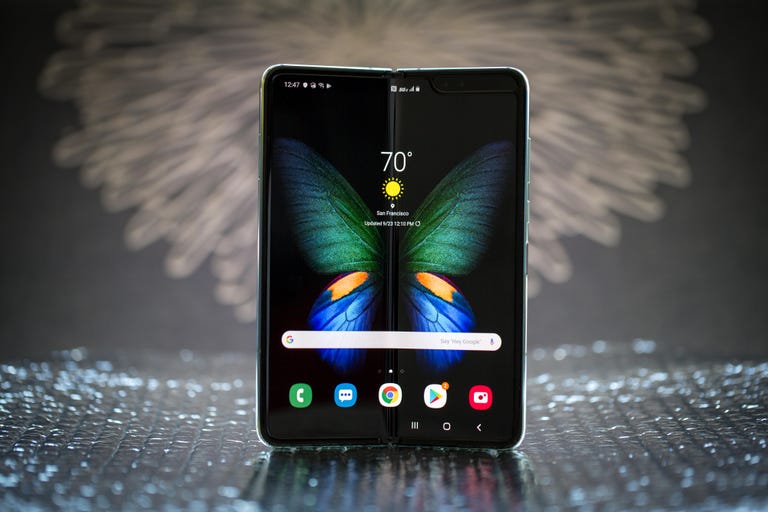 Why You Can Trust CNET
Why You Can Trust CNET Samsung Galaxy Fold review: The device that piqued our interest in a foldable phone future
Despite being riddled with problems, the Galaxy Fold makes for an interesting blueprint for future foldables.
Update, Aug. 10, 2020: The Galaxy Z Fold 2 is here. Read our ongoing coverage. Our Galaxy Fold review, originally published Oct. 3, 2019, follows.
The Good
The Bad
The Bottom Line
It's unusual for a phone as new as the Galaxy Fold to be so battle-worn. In the course of its short life, the foldable phone went from the pinnacle of hype for our collective mobile future to cautionary tale about companies that rush to sell radical, under-tested technology. (Here's a brief history of what went wrong with Samsung's delicate plastic display.)
Read more: Forget the Galaxy Fold: This zigzagging foldable phone from TCL bends into thirds
Now, after testing and using two versions of the Galaxy Fold -- the original model and this redesigned version that fixes Samsung's biggest design flaws -- everything wonderful and terrible with the $1,980 (£2,000, AU$2,950) Galaxy Fold is crystal clear.
As a blueprint for how foldable phones could be truly useful, it undeniably succeeds. There's something physically satisfying about using the Fold, and its 7.3-inch screen is a dream for watching movies, looking at photos and reading anything. Wanting to multitask felt natural, and more than once I used the Fold as a second screen that was easy to fold up and zip into my jacket pocket the moment I was done.
But as big a favor as the Fold does for all foldable-phone kind in proving that yes, we do want to see where foldable phones go, the Fold itself is still lacking when it comes to creature comforts.
The Galaxy Fold has its charms, and also some rough spots.
Microsoft has thrown a twist in the middle of this foldable awakening, introducing a surprising double-screen phone of its own. Although we won't see the Surface Duo for a year, Microsoft's dual-screen phone throws down the gauntlet against the Galaxy Fold and foldable design in general: Why use such a problematic folding screen when you can just have two displays?
Samsung fixed the most hazardous errors to the Fold's display, the ones that caused the phone to stop working. But it didn't fix some more baked-in problems. The phone remains too expensive and too fragile, with some puzzling choices that give the inner screen an enormous notch and a plasticky bezel, and the outer screen a cramped keyboard that's just no fun to use.
Battery life is strangely shorter than it seems it should be, despite two cells (on on each side of the hinge) that forms the equivalent of a 4,500-mAh battery. It lasted an average of 12 hours, 15 minutes in CNET's looped video test in airplane mode, compared to over 21 hours for the Galaxy Note 10 Plus.
Samsung's foldable phone is about more than just its specs.
In its defense, the Galaxy Fold was always greater than itself. It's a proof of concept meant to prime the pump for later devices. That said, Samsung clearly wanted people to buy the phone as a luxury device, a status symbol that early adopters with plenty of cash could casually unfold to wow their peers with an unusual, instantly recognizable design.
Unfortunately, that's backfired now. I'll argue with naysayers that, as a concept, the foldable phone has potential. Just as long as the industry figures out how to make a stronger screen, be it from thin, bendable glass that doesn't commercially exist yet to some other hardened plastic material.
But in the present tense, I don't recommend the Galaxy Fold specifically, even if you have cash to spare. More foldable phones are coming, from Samsung, Huawei and even Microsoft. Do yourself a favor and wait.
For more detail, here's a breakdown of the Galaxy Fold features we like most -- and least.
Galaxy Fold specs
| Display size, resolution | 4.6-inch Super AMOLED; 7.3-inch QXGA+ Dynamic AMOLED |
|---|---|
| Dimensions (Millimeters) | Folded: 62.8 x 161 x 15.7mm ~ 17.1mm Unfolded: 117.9 x 161 x 6.9mm ~ 7.6mm |
| Weight (Ounces, Grams) | 9.7 oz; 276g |
| Mobile software | Android 9.0 with Samsung One UI |
| Camera | 12-megapixel (wide-angle), 16-megapixel (ultra wide-angle), 12-megapixel (telephoto) |
| Front-facing camera | Two 10-megapixel, 8-megapixel 3D depth |
| Video capture | 4K (HDR 10+) |
| Processor | Qualcomm Snapdragon 855 |
| Storage | 512GB |
| RAM | 12GB |
| Expandable storage | No |
| Battery | 4,380mAh |
| Fingerprint sensor | Power button |
| Connector | USB-C |
| Headphone jack | No |
| Special features | Foldable display, wireless charging, fast charging |
| Price off-contract (USD) | $1,980 |
| Price (GBP) | £2,000 |
| Price (AUD) | AU$2,950 |
First published Oct. 3, 2019.


